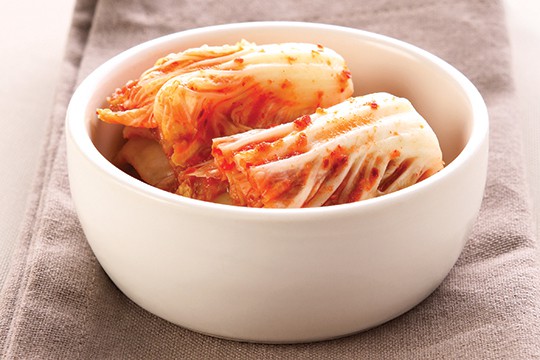Kimchi
You’ll need a large crock for this recipe—any large, widemouthed storage container will work (such as a glass flour storage container or the stoneware vessels that store kitchen utensils).
Ingredients
- 1 large head about 2 pounds Napa cabbage, quartered, cored, and thinly sliced
- ½ pound carrots peeled and thinly sliced or grated
- ½ pound daikon or red radishes or a combination, thinly sliced or grated
- 3 tablespoons grated fresh ginger
- 4 scallions roots removed, cut into ½-inch pieces
- 6 large cloves garlic peeled and thinly sliced
- ¼ to ½ cup diced hot peppers such as jalapeños, cherry peppers, or Hungarian wax peppers (depending on desired heat level)
- 1½ tablespoons kosher salt plus more as necessary
- 2 teaspoons fish sauce optional
Instructions
- Combine cabbage, carrots, radishes, ginger, scallions, garlic, hot peppers, and salt in a large mixing bowl. Put on clean dish gloves to protect your hands from the peppers. Squeeze and massage mixture until the vegetables release their juices.
- Scrape mixture and any liquid into a ceramic crock or similar vessel. Place a small plate over the vegetables in the crock and top with a small jar filled with water (to weigh down the plate). Lay a clean dish towel over the crock and store in a cool corner of your kitchen. Check after 24 hours. If liquid does not entirely cover the vegetables, make a saltwater solution (1 teaspoon kosher salt to 1 cup water) and use what you need to keep them submerged.
- Keep an eye on the kimchi over the next few days. Some bubbling is a good sign, and a thin layer of white scum is fine (just skim it off). After about 5 days, taste the kimchi. It should still be crunchy, but shouldn’t taste like raw cabbage or be too salty. If you like the taste and texture, stir in fish sauce, if using; transfer to a ½-gallon glass jar; cover; and store in the refrigerator. If it’s too salty or crunchy or hasn’t acquired a strong enough flavor, let it ferment another few days and taste again, repeating for up to 2 weeks total. The longer the kimchi ferments, the funkier it will become. When it’s done to your liking, stir in the fish sauce, if using; transfer to a ½-gallon glass jar; cover; and store in the refrigerator for up to 6 months.
Notes
Traditional kimchi usually contains gochugaru (Korean red pepper flakes) and dried shrimp. To add these ingredients, use about ¼ cup of red pepper and scale back your fresh hot peppers. Mix in about 2 tablespoons of dried shrimp.
Keep the vegetable-to-salt ratio constant at 3 pounds of vegetables to 1½ tablespoons of salt, but feel free to cut back on the cabbage and increase the radishes, carrots, ginger, or hot peppers in the mix.
No radishes? White spring turnips or sweet scarlet turnips are great alternatives.
All types of cabbage—standard red or green varieties, savoy, or bok choy—work in kimchi. Experiment!
Keep the vegetable-to-salt ratio constant at 3 pounds of vegetables to 1½ tablespoons of salt, but feel free to cut back on the cabbage and increase the radishes, carrots, ginger, or hot peppers in the mix.
No radishes? White spring turnips or sweet scarlet turnips are great alternatives.
All types of cabbage—standard red or green varieties, savoy, or bok choy—work in kimchi. Experiment!
